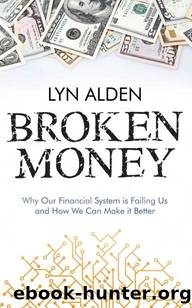Broken Money: Why Our Financial System is Failing Us and How We Can Make it Better by Lyn Alden

Author:Lyn Alden [Alden, Lyn & Alden, Lyn]
Language: eng
Format: epub
Publisher: Timestamp Press
Published: 2023-08-24T22:00:00+00:00
Figure 19-A283
Federal debt accumulation, meanwhile, tends to run countercyclically to this trend. Federal debt increases swiftly during recessions, because tax revenues fall due to lower economic output, and federal spending increases to offer extra unemployment benefits and other fiscal stimulus. Meanwhile, the United States engaged in the âWar on Terrorâ which more-so than prior wars was financed by debt.
Figure 19-B284
If the government is trying to smooth out economic growth via countercyclical policies in a sustainable way, then in that framework the government should run a surplus and build a reserve during an economic expansion and then run a deficit from that reserve during a contraction, so that over the course of a full cycle the budget is balanced but is also flexible. In reality, due to the incentive structure that politicians operate under, they run fiscal deficits almost all the time. Thereâs little or no political incentive to run a surplus in any near term, and so it is rarely ever done. Therefore, public debt relative to the size of the economy normally moves mildly upward even during times of strong economic growth, and then further accelerates upward during recessions. Meanwhile, whenever private sector debt risks contracting even mildly, monetary policymakers step in to stop that from happening too broadly.
Figure 19-C shows total U.S. debt (public and private combined) from the start of 1952 ($461 billion) to the end of 2022 ($93.5 trillion). The reader can see the smooth, tightly curated trend upwards. Throughout this entire seven-decade period, the total amount of debt in the system was never allowed to decrease, except for a brief period amid the massive 2008 financial crisis where it managed to fall by just 1.3% before continuing its smooth, ever-higher, trend.
Download
This site does not store any files on its server. We only index and link to content provided by other sites. Please contact the content providers to delete copyright contents if any and email us, we'll remove relevant links or contents immediately.
| ASVAB | GED |
| GRE | NCLEX |
| PRAXIS | SAT |
| See more | Flash Cards |
| Study Guides | Study Skills |
| Workbooks |
Talking to Strangers by Malcolm Gladwell(13222)
The Compound Effect by Darren Hardy(8808)
Tools of Titans by Timothy Ferriss(8216)
Wonder by R. J. Palacio(8007)
The Lover by Duras Marguerite(7827)
A Court of Wings and Ruin by Sarah J. Maas(7648)
The Circle by Dave Eggers(7035)
Deep Work by Cal Newport(6878)
Kaplan MCAT General Chemistry Review by Kaplan(6866)
To All the Boys I've Loved Before by Jenny Han(5772)
Wiseguy by Nicholas Pileggi(5669)
The Body: A Guide for Occupants by Bill Bryson(4974)
1,001 ASVAB Practice Questions For Dummies by Powers Rod(4452)
Eat That Frog! by Brian Tracy(4432)
Cracking the GRE Premium Edition with 6 Practice Tests, 2015 (Graduate School Test Preparation) by Princeton Review(4224)
Pre-Suasion: A Revolutionary Way to Influence and Persuade by Robert Cialdini(4144)
Barron's AP Biology by Goldberg M.S. Deborah T(4096)
ACT Math For Dummies by Zegarelli Mark(3993)
Alive: The Story of the Andes Survivors by Piers Paul Read(3967)
